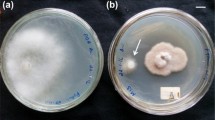Abstract
Soft rot caused by Pythium sp. is a major challenge to the cultivation of Zingiber officinale Rosc. (Ginger). In the present study, endophytic Serratia sp. ZoB14 isolated from ginger rhizome was found to have inhibitory effect towards Pythium myriotylum and also against other pathogens. This was confirmed by dual culture and scanning electron microscopic analysis. Further, ZoB14 was identified to have the presence of aminopyrrolnitrin oxidase gene involved in the biosynthesis of pyrrolnitrin. The rhizome bacterization with ZoB14 has revealed its protective effect to ginger from Pythium infection. In addition, the organism was observed to have the presence of an array of plant growth promoting traits with in vivo growth enhancement effect on Vigna unguiculata seedlings. Even though Serratia species have previously been reported for antifungal properties, its plant growth supportive features and isolation from rhizome of ginger make the study highly significant.







Similar content being viewed by others
References
Strobel G, Daisy B (2003) Bioprospecting for microbial endophytes and their natural products. Microbiol Mol Biol Rev 67(4):491–502. https://doi.org/10.1128/MMBR.67.4.491
Rosenblueth M, Martínez-romero E (2006) Bacterial endophytes and their interactions with hosts. Mol Plant Microbe Interact 19(8):827–837
Alstrom S (2001) Characteristics of bacteria from oilseed rape in relation to their biocontrol activity against Verticillium dahliae. J Phytopathol 149(2):57–64
Chung H, Park M, Madhaiyan M, Seshadri S, Song J, Cho H, Sa T (2005) Isolation and characterization of phosphate solubilizing bacteria from the rhizosphere of crop plants of Korea. Soil Biol Biochem 37(10):1970–1974. https://doi.org/10.1016/j.soilbio.2005.02.025
Boiero L, Perrig D, Masciarelli O, Penna C, Cassan F, Luna V (2006) Phytohormone production by three strains of Bradyrhizobium japonicum and possible physiological and technological implications. Appl Microbiol Biotechnol 74(4):874–880. https://doi.org/10.1007/s00253-006-0731-9
Glick B (2012) Plant growth-promoting bacteria: mechanisms and applications. Scientifica. https://doi.org/10.6064/2012/963401
Radhakrishnan EK, Bava SV, Narayanan SS, Nath LR, Thulasidasan AK, Soniya EV, Anto RJ (2014) [6]-Gingerol induces caspase-dependent apoptosis and prevents PMA-induced proliferation in colon cancer cells by inhibiting MAPK/AP-1 signaling. PLoS ONE 9(8):e104401
Thomas P, Upreti R (2014) Testing of bacterial endophytes from non-host sources as potential antagonistic agents against tomato wilt pathogen Ralstonia Solanacearum. Adv Microbiol 4:656–666
Jasim B, Anisha C, Rohini S, Kurian JM, Jyothis M, Radhakrishnan EK (2014) Phenazine carboxylic acid production and rhizome protective effect of endophytic Pseudomonas aeruginosa isolated from Zingiber officinale. World J Microbiol Biotechnol 30(5):1649–1654
Anisha C, Radhakrishnan EK (2015) Gliotoxin-producing endophytic Acremonium sp. from Zingiber officinale found antagonistic to soft rot Pathogen Pythium myriotylum. Appl Biochem Biotechnol 175(7):3458–3467. https://doi.org/10.1007/s12010-015-1517-2
Gyaneshwar P, James EK, Mathan N, Reddy PM, Reinhold-hurek B, Ladha JK (2001) Endophytic colonization of rice by a diazotrophic strain of Serratia marcescens. J Bacteriol 183(8):2634–2645. https://doi.org/10.1128/JB.183.8.2634
Montealegre JR, Reyes R, Perez LM, Herrera R, Silva P, Besoain X (2003) Selection of bioantagonistic bacteria to be used in biological control of Rhizoctonia solani in tomato. Electron J Biotechnol 6(2):38–50. https://doi.org/10.2225/vol6-issue2-fulltext-8
Staniszewska M, Bondaryk M, Swoboda-Kopec E, Siennicka K, Sygitowicz G, Kurzatkowski W (2013) Candida albicans morphologies revealed by scanning electron microscopy analysis. Braz J Microbiol 44(3):813–821. https://doi.org/10.1590/S1517-83822013005000056
Jasim B, Sreelakshmi KS, Mathew J, Radhakrishnan EK (2016) Surfactin, iturin, and fengycin biosynthesis by Endophytic bacillus sp. from Bacopa monnieri. Microb Ecol 72(1):106–119
Jimtha JC, Jishma P, Arathy GB, Anisha C, Radhakrishnan EK (2016) Identification of plant growth promoting rhizosphere Bacillus sp. WG4 antagonistic to Pythium myriotylum and its enhanced antifungal effect in association with Trichoderma sp. J Soil Sci Plant Nutr. https://doi.org/10.4067/S0718-95162016005000026
Gordon SA, Weber RP (1951) Colorimetric estimation of indole acetic acid. Plant Physiol 26(1):192–195
Jimtha John C, Smitha PV, Anisha C, Deepthi T, Meekha G, Radhakrishnan EK, Gayatri GP, Remakanthan A (2014) Isolation of endophytic bacteria from embryogenic suspension culture of banana and assessment of their plant growth promoting properties. Plant Cell Tissue Organ Cult 118(1):57–66. https://doi.org/10.1007/s11240-014-0461-0
Jasim B, Jimtha CJ, Jyothis M, Radhakrishnan EK (2013) Plant growth promoting potential of endophytic bacteria isolated from Piper nigrum. Plant Growth Regul 71(1):1–11. https://doi.org/10.1007/s10725-013-9802-y
Saravanan VS, Subramoniam SR, Raj SA (2004) assessing in vitro solubilization potential of different zinc solubilizing bacterial (zsb) isolates. Braz J Microbiol 35:121–125
Baykov AA (1988) A malachite green procedure for orthophosphate determination and its use in alkaline phosphatase-based enzyme immunoassay. Anal Biochem 270:266–270
Escamilla JE, Kennedy C (2004) Indole-3-acetic acid biosynthesis is deficient in Gluconacetobacter diazotrophicus strains with mutations in cytochrome c biogenesis genes. J Bacteriol 186(16):5384–5391. https://doi.org/10.1128/JB.186.16.5384
Gao K (2010) Biocontrol potential of an endophytic Serratia sp. G3 and its mode of action. World J Microbiol Biotechnol 26:1465–1471. https://doi.org/10.1007/s11274-010-0321-y
Nalini S, Parthasarathi R (2014) Production and characterization of rhamnolipids produced by Serratia rubidaea SNAU02 under solid-state fermentation and its application as biocontrol agent. Bioresour Technol 173:231–238. https://doi.org/10.1016/j.biortech.2014.09.051
Haas D, Defago G (2005) Biological control of soil-borne pathogens by fluorescent pseudomonads. Nat Rev Microbiol 3(4):307–319. https://doi.org/10.1038/nrmicro1129
Chen T, Chen Z, Ma GH et al (2014) Diversity and potential application of endophytic bacteria in ginger. Genet Mol Res 13:4918–4931
Ahemad M, Kibret M (2014) Mechanisms and applications of plant growth promoting rhizobacteria: current perspective. J King Saud Univ Sci 26:1–20. https://doi.org/10.1016/j.jksus.2013.05.001
Nadeem SM, Zahir ZA, Naveed M, Arshad M (2009) Rhizobacteria containing ACC-deaminase confer salt tolerance in maize grown on salt-affected fields. Can J Microbiol 55(11):1302–1309. https://doi.org/10.1139/W09-092
Zaheer A, Mirza BS, Mclean JE, Yasmin S, Shah TM, Malik KA, Mirza MS (2016) Association of plant growth-promoting Serratia spp. with the root nodules of chickpea. Res Microbiol 167(6):510–520. https://doi.org/10.1016/j.resmic.2016.04.001
Acknowledgements
This work was funded by The Kerala State Council for Science, Technology and Environment for the KSCSTE—Fellowship (Council Order No. 010—40/FSHP/2010CSTE), Kerala State Council for Science, Technology and Environment-Science Research Scheme (274/2015, KSCSTE Dated 6 July 2015) and Kerala State Council for Science, Technology and Environment-Selective Augmentation of Research & Development (1223/2014/KSCSTE Dated 8/1/2014).
Author information
Authors and Affiliations
Corresponding author
Ethics declarations
Conflict of interest
The authors declared that they have no conflict of interest.
Additional information
Significance of the study Endophytic Serrati a sp. ZoB14 isolated in the study was identified to have both biocontrol and plant growth promoting features. This indicates its promises to develop into bioinoculant for environment friendly agricultural practices.
Electronic supplementary material
Below is the link to the electronic supplementary material.
Rights and permissions
About this article
Cite this article
Sabu, R., Aswani, R., Jishma, P. et al. Plant Growth Promoting Endophytic Serratia sp. ZoB14 Protecting Ginger from Fungal Pathogens. Proc. Natl. Acad. Sci., India, Sect. B Biol. Sci. 89, 213–220 (2019). https://doi.org/10.1007/s40011-017-0936-y
Received:
Revised:
Accepted:
Published:
Issue Date:
DOI: https://doi.org/10.1007/s40011-017-0936-y




